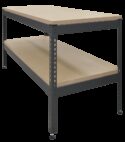Experimento
STS13

Continuous and Indeterminate Beams (Next Generation Structures)
Experiment that can be used to perform a wide variety of beam experiments, from simple cases to complex problems. Mounts on the Structures test frame and connects to the Structures automatic data acquisition unit and software.
If you have any questions or you'd like to discuss a product, please call us.
+44 1159 722 611Continuous and Indeterminate Beams (Next Generation Structures)
One of a range of experiment modules that fit to the Structures platform (STS1, available separately), this product provides a comprehensive set of experiments for the subject of beams and their support reactions and deflections.
The first experiments use two simple supports and a ‘rigid’ and heavy beam to examine statically determinate systems. Students learn basic principles such as moments, the principle of superposition, uniformly distributed loads (UDLs) and the concept of the infl uence line.
The second set of experiments relate to more advanced beam structures that are statically indeterminate, or involve a measureable beam defl ection. Students use a light and ‘fl exible’ beam. Using a ‘flexible’ beam allows students to consider the supports signifi cantly more rigid, so the normal textbook theory becomes valid. Two additional supports help complete the experiments. One allows measurement of the support fixing moment, the other ‘universal support’ works as simple support, a clamped support and a sinking knife edge support. A precision indicator on a slide can be easily positioned to measure beam defl ections. All supports and the indicator slide have pointers that work with the scale and the platform for accurate position.
Note: The alternative product, Equilibrium of a Simply Supported Beam (STS22), contains the first set of this experiment module’s experiments as a more economical option if you do not need the more advanced areas of study.
Students apply loads to any position along the beams and measure the resulting reactions, deflections and moments. They use textbook beam equations to predict the results for any given load and compare the calculated results with the measured results. This helps confi rm the reliability of the textbook equations and the accuracy of the experiment results.
The deflection indicator has its own display but it can connect (with the load cells) to the USB interface hub of the Structures platform for computer display and data acquisition.
Learning outcomes
• Principle of moments
• Reactions for a point load along a simply supported beam
• Reactions for a uniformly distributed load (UDL) on a simply supported beam
• The principle of superposition
• Influence Lines
• Deflection of a simply supported beam
• Reactions for a continuous beam
• Reactions and moments of a propped cantilever
• Reactions and moments of a fi xed beam
• The effect of a sinking support


















